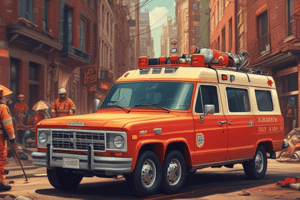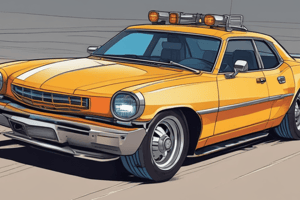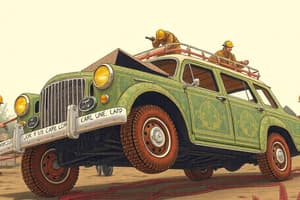Podcast
Questions and Answers
What is a crucial step regarding apparatus placement at a vehicle accident scene?
What is a crucial step regarding apparatus placement at a vehicle accident scene?
- Consider safety hazards like fuel leaks and downed power lines. (correct)
- Place the apparatus in a random location to prevent crowd control.
- Park downhill to avoid hazardous materials.
- Place apparatus in locations without regard to wind direction.
Who is responsible for communicating incident benchmarks at the scene?
Who is responsible for communicating incident benchmarks at the scene?
- The dispatch operator.
- The Incident Commander. (correct)
- The first officer arriving at the scene.
- The safety officer.
Which of the following should NOT occur in the Hot Zone during an incident?
Which of the following should NOT occur in the Hot Zone during an incident?
- Assessment of the area without prior approval.
- Citizen access without protective gear. (correct)
- Law Enforcement directing traffic.
- Emergency personnel in full protective equipment.
What must be ensured before beginning the extrication process in vehicle accidents?
What must be ensured before beginning the extrication process in vehicle accidents?
What should be established to ensure no access to live electrical wires?
What should be established to ensure no access to live electrical wires?
Which of the following practices is recommended for vehicles at accident scenes?
Which of the following practices is recommended for vehicles at accident scenes?
What should a Company Officer ensure regarding personnel on-scene?
What should a Company Officer ensure regarding personnel on-scene?
During the management of a vehicle incident, which of the following is a primary safety consideration?
During the management of a vehicle incident, which of the following is a primary safety consideration?
What is the primary purpose of cribbing and chocking a vehicle that is on its side or upside down?
What is the primary purpose of cribbing and chocking a vehicle that is on its side or upside down?
Which tool is NOT mentioned as a specialized piece of equipment for vehicle stabilization?
Which tool is NOT mentioned as a specialized piece of equipment for vehicle stabilization?
When handling a vehicle with undeployed airbags, what safety measure should be prioritized?
When handling a vehicle with undeployed airbags, what safety measure should be prioritized?
What action should be taken regarding the vehicle's electrical system during an extrication?
What action should be taken regarding the vehicle's electrical system during an extrication?
What technique should be used to protect front seat occupants during potential airbag deployment?
What technique should be used to protect front seat occupants during potential airbag deployment?
Why is it important to visually check for airbags and curtains in a vehicle before extrication?
Why is it important to visually check for airbags and curtains in a vehicle before extrication?
Which of the following describes a potential consequence of not stabilizing a vehicle properly?
Which of the following describes a potential consequence of not stabilizing a vehicle properly?
What should be considered a 'loaded' airbag?
What should be considered a 'loaded' airbag?
What should be done to minimize the danger of airbag activation after an accident?
What should be done to minimize the danger of airbag activation after an accident?
Which type of fuel is NOT typically used in modern vehicles?
Which type of fuel is NOT typically used in modern vehicles?
During extrication from vehicles, which airbags need special caution?
During extrication from vehicles, which airbags need special caution?
What action should be prioritized when dealing with fuel spills during an incident?
What action should be prioritized when dealing with fuel spills during an incident?
In the event of significant danger such as a fire during extrication, what is required?
In the event of significant danger such as a fire during extrication, what is required?
What is the first step after cutting battery cables during vehicle extrication?
What is the first step after cutting battery cables during vehicle extrication?
Which device is associated with the activation devices that require caution during extrication?
Which device is associated with the activation devices that require caution during extrication?
What should be done if cutting and removing battery cables is not feasible?
What should be done if cutting and removing battery cables is not feasible?
Flashcards are hidden until you start studying
Study Notes
Vehicle Stabilization Techniques
- Vehicles on their sides, on barriers, or upside down must be cribbed and chocked using current stabilization techniques to prevent movement.
- Specialized equipment for vehicle stabilization includes:
- Kodiak Stabilization Kits
- Capabear Claw Stabilization Kits
- Lift Bags
- Chains and Webbing
Patient Extrication Considerations
- Un-deployed airbags are classified as “loaded” and can deploy unintentionally during extrication efforts.
- Perform a visual scan of the vehicle interior for airbags or curtains before extrication.
- Maintain a safe distance from airbags; immobilization of front seat passengers should be done from the rear seat.
- Elevate tilt steering to its highest position and move front seats back to minimize trauma from potential airbag deployment.
- Shut down the vehicle's electrical system early to prevent accidental airbag deployment.
Apparatus Placement
- Apparatus placement is crucial and must adhere to established protocols like SOG 310-01 Traffic Operations.
- Consider safety hazards such as:
- Fuel leaks/spills—position apparatus uphill and upwind.
- Hazardous materials—park uphill and upwind to mitigate risks.
- Downed electrical power lines and potential damage to power poles.
Scene Stabilization Protocols
- Follow additional safety protocols outlined in SOG 310-01 Traffic Operations.
- Ensure all personnel wear appropriate PPE suitable for immediate hazards.
- Establish a Hot Zone; restrict entry for those without PPE.
- Isolate live electrical wires and create an Exclusion Zone where no entry is permitted.
Vehicle Stabilization Requirements
- All damaged vehicles are unstable and must be stabilized to prevent further movement during extrication.
- Always place vehicles in park, turn off engines, and chock wheels.
- Battery systems should be powered down to reduce risk; cutting negative cables first is recommended.
- Remove battery cables safely and ensure they do not reconnect inadvertently.
Extrication Safety Precautions
- Avoid damaging activation devices of airbags during extrication:
- Loaded side impact airbags (located in doors and seats)
- Seatbelt pre-tensioning devices
- Rollover airbags (located at various posts)
- Knee airbags (front dash)
- Inflatable seatbelts
- Deploy a 1¾” hose line during extrication for fire protection.
- Assign personnel to handle hose lines when fire threat is significant.
Fuel Types Present in Vehicles
- Common types of fuel used in modern vehicles include:
- Gasoline
- Diesel
- Gasoline-electric hybrid
- Plug-in hybrid
- Battery electric
Studying That Suits You
Use AI to generate personalized quizzes and flashcards to suit your learning preferences.




